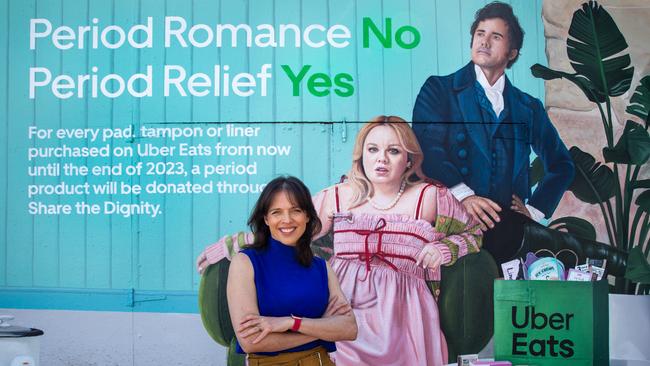Uber pushes period piece ad campaign for a good cause
Uber Eats is using one of its new million dollar advertising campaigns featuring Irish actress Nicola Coughlan as a force for good.

Uber Eats is using one of its new advertising campaigns as a force for good. The online food ordering and delivery platform has extended part of its latest million-dollar campaign to include a charitable initiative with women’s services network WESNET and a donation program with Share the Dignity.
The campaign is an extension of a video ad released in mid-September and aims to help women, girls and people who menstruate get access to menstrual products for free. Uber Eats will donate one period product for every equivalent product sold via the Uber Eats app from today until the end of the year.
The initiative also comes as Uber Eats marks nearly one year into its pursuit to reposition its brand to include takeaway deliveries as well as groceries, alcohol and other household goods.
To do this, the brand rolled out its “Get almost, almost anything” tagline, off the back of the salience-driving engine that was “Tonight I’ll be eating”, which are Australian-born creative innovations from advertising agency Special Group. Both platforms have been scaled globally by Uber Eats. Taiwan, Spain, Mexico, the US and Canada are the latest to receive the “Get almost, almost anything” campaign.
One of the newly released advertisements featured Harry Potter actor Tom Felton, and the other, Irish actress Nicola Coughlan, who starred in the hit Netflix period drama Bridgerton.
The period poverty initiative is linked to the video advertisement featuring Coughlan, in which she is shown watching a period drama.
In the advertisement, she looks quizzically at her mobile device, opens the Uber Eats app, and tries to order “Period romance”.
In the clip, suddenly, a Mr Darcy-type suitor arrives on her doorstep, standing in an Uber Eats branded delivery bag, holding a bunch of flowers. The expression on Coughlan’s face is revealing, as she coyly says “Hi” to the handsome stranger and bats her eyelashes. The plot line sets the audience up to take a front-row seat to a blossoming romance. Love has arrived.
But the Uber Eats-delivered suitor is from another era, when women did not enjoy liberties that are considered normal to life in many parts of the world today.
In one scene, a suit-clad Coughlan rushes off to work, collecting some documents from her kitchen table on her way out the door. Her suitor chuckles, “A woman, with a job?” He also searches her apartment for a chamber pot, has an odd fascination with ankles (which were considered an impropriety to show in public in the Victorian era) and excitedly assumes a bridal dowry of cattle and land.
The clip culminates after the increasingly frustrated Coughlan’s dream partner mistakes an electric rice cooker for a chamber pot. The story pivots to Coughlan sitting comfortably on her couch, with two lines that sum up the proposition from Uber Eats. The line “Period romance, No. Period relief, Yes” appears alongside a delivery bag containing ice cream, period underwear, a hot water bottle and menstruation pads.
This storyline, therefore, extends naturally into Uber Eats longstanding partnership with WESNET, and the advertisement’s story was architected with the initiative in mind.
Today, one in five Australians who menstruate has had to improvise on a period product due to cost, and half of Australian women and girls have worn a pad for more than four hours because they didn’t have access to enough products. Lucinda Barlow, senior director and head of international marketing for Uber, said she was personally surprised by these numbers. She said Uber Eats wanted to use the scale and reach of its platform to address the issue.
Special Australia managing director Lauren Portelli told The Growth Agenda: “Menstruation products are an unspoken part of half our population’s monthly shop. Uber Eats is celebrated for tapping into culture and this campaign with Nicola has allowed Uber to spark a cultural conversation around flow coming to town.”
Ms Barlow added brands can be both commercial and make a positive social impact.
“As CMOs and brand marketers, our role is to strengthen our brand. And it’s to play a deeper role in consumers’ lives. Advertising, when done well, has to engage. And that engagement can happen in lots of ways,” she said.
“Where this works really well is when the engagement that you want in your brand, and your advertising, aligns with what your consumers really care about. And there is also a proposition that you can deliver on.”
Ms Barlow said Uber Eats’ donation-led initiative achieves this.
Ms Barlow has long championed creativity and brand marketing – the kind that aims to cultivate strong and lasting relationships with its customers over time.
The Australian understands the brand is currently spending nearly 25 per cent of its entire brand marketing budget locally on YouTube.
The video streaming platform is one of many in the channel mix for the latest advertising campaigns featuring Coughlan and Felton, along with TV, social media, outdoor and digital placements.
The extension of the campaign comes with its own unique advert, and Ms Barlow hopes media channels will offer advertising inventory pro bono to support the cause. Publisher Are Media is among those who have done so.
The original video ads are already seeing early signs of success, Ms Barlow said, including “positive feedback” on social media and “virality” for both the Period Romance campaign and the spot featuring Tom Felton.
Growth-seeking brands, more broadly, have long chased “fame” and popularity through marketing to connect with consumers. Humour is a particularly potent storytelling device, as previous Uber Eats campaigns have demonstrated.
Val Morgan’s director of content Julia Willing was among the publishers to report on the video ads featuring Coughlan and Felton. She wrote of Coughlan’s ad on Buzzfeed: “Honestly, more worthy of an Oscar nomination than most films I’ve watched this year.”
Buzzfeed has regularly covered Uber Eats’ adverts, and Ms Willing puts the campaign’s popularity among its readers down to “the ability of the Eats team to choose iconic talent – often rooted in nostalgia for Aussie readers – and weave such original, hilarious narratives”.
When it comes to media channel selection for Uber Eats’ advertising across its multibillion-dollar advertising budget, does the media channel inform the creative “big idea”, or vice versa?
“The idea always comes first,” Ms Barlow said. “But we work so closely together and certainly some ideas cannot be executed with a channel plan that you have.
“You need to really know your channels in order to think about the idea but at the same time, channels can also spark incredible ideas.
“But you want to ensure you have an idea that is backed by a core insight that is going to have consistency, that is going to resonate. And in this case, that is going to do some good.”







